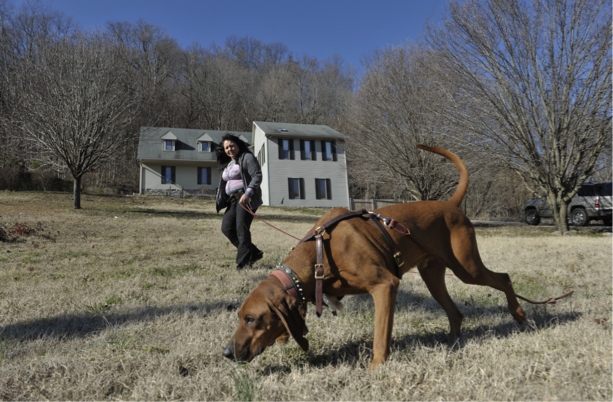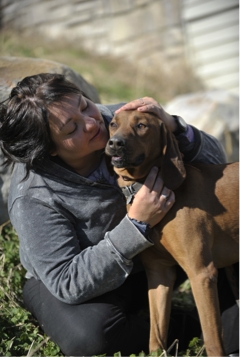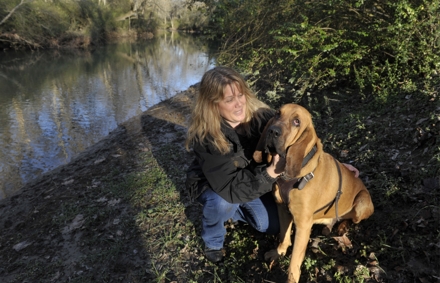Search and rescue dogs fill valuable role
VUMC surgeon and LifeFlight nurse team to serve their community with amazing canines

Dogs experience the world through their noses. With an average of 200 million scent receptors (compared to a measly 5 million in humans), dogs can pick up a scent from a mere handshake and follow trails that are years old.
That was good news for the family of Johnny Hahn, a 9-year-old boy with autism who wandered into the Maury County woods last August. Volunteers had combed the area around his aunt and uncle’s house with no sign of the boy, so the Maury County Sheriff called in Ysela Carrillo, M.D., and her redbone coonhound Mason. Using a pair of shorts the boy had slept in the night before, Mason was able to track down Johnny, who was playing in creek about a mile from the house he wandered from.
“There were 70 volunteers on foot that preceded us in the search, and Mason was able to filter all that out and find just the one scent trail for the boy,” Carrillo said. “The sun was going down and people were getting worried, and luckily we were able to find him pretty quick.”
Carrillo, assistant professor of Surgery at Vanderbilt University Medical Center, and Erica Woodside, B.S.N., R.N., E.M.T., LifeFlight nurse, are both reserve deputies with the Maury County Sheriff’s Office (complete with shiny silver star-shaped badges) and participate in search and rescue activities with their trained dogs.
Using the dogs’ keen sense of smell and natural desire to track scents, they help find Alzheimer’s patients who wander from home, follow the trail of abducted people or criminals and locate drowning victims.
Amazing noses
“The hounds’ olfactory cells are more dense, and it’s amazing what they can smell. They can track trails that are months or years old or get scent off a piece of clothing the person wore seven or eight years ago,” Carrillo said.
Carrillo has two coonhounds named Mason and Dixon, a German Shepherd named Grizzly and a Belgian Malinois named Cleo, each with their own set of search and rescue strengths.

“Dixon is good for city work because he’s not afraid of noises or trains. Cleo is very obedient and can be let off leash when she’s searching,” she said.
Woodside has two bloodhounds, a male named Buford and female named JC.
“Buford is very mild-mannered and can work some off leash. He’s 110 pounds but thinks he’s a lap dog, so he does very well in a boat. JC is very fast-paced and will barge on through anything, so she’s good in the woods,” Woodside said.
Carillo and Woodside had known each other from working on trauma cases at Vanderbilt but got reacquainted through search and rescue activities and now go on many calls together.
“It’s great having someone like Ysela doing this with me,” Woodside said. “It seems quaint at my age to say this, but she’s my best friend. It’s very nice having someone who has had the same training, knows what to do and is there to back you up.”
Excitement in the air
Both of them started with very active dogs that needed to be stimulated. Now they train six-eight hours every weekend with a group led by Tim and Suzy Perry in Sumner County, a couple nationally known in search and rescue operations. Reputation is important in the field, and both Carrillo and Woodside trained for years before the Maury County Sheriff considered using them.
The dogs live to search, and just putting them in the car or showing them their special work harness elicits excited barks, jumps and tail wags.
To signal it is time to work, the handler straddles the dog and puts them in their harness. Then the dog is allowed to smell the area in a process called casting.
“Casting them out gives them an impression in their head. The Perrys taught us that dogs can subtract better than they can add. If they have smelled everything and then you give them a scent, they can tell that that scent isn’t around anymore and go find it,” Woodside explained.
After casting, an object containing the missing person’s scent is clasped over the dog’s nose and the handler gives them audible cues to “Check it” and “Go find it.”
“They can get a scent from just a hair or from a quarter that has been bounced off someone’s clothes. That’s enough contact to get a scent,” Carillo said. “We usually find what we’re looking for. The dogs are tenacious and keep going until they find them.”

One of their busiest periods was the May 2010 flood, as they searched for people swept away by the rushing water, including Danny Tomlinson, who was missing for months.
“That was our most disappointing search. We spent many weekends looking for him, but it was his sister who eventually found his body,” Carillo said.
Woodside said her proudest moment was Buford’s first successful find, the body of a man who was missing in 38 feet of water.
“I was proud even though it was very sad. It’s satisfying when we can give the family closure,” she said.
Most police forces can’t afford fully trained search and rescue dogs, and rely on volunteers like Carrillo and Woodside to assist with searches. Both say they are motivated by giving back to the community and by keeping their dogs active.
“We both believe in community service or we wouldn’t be in the line of work we’re in,” Woodside said. “We also love dogs, but know they can serve a purpose.”

Leave a Response